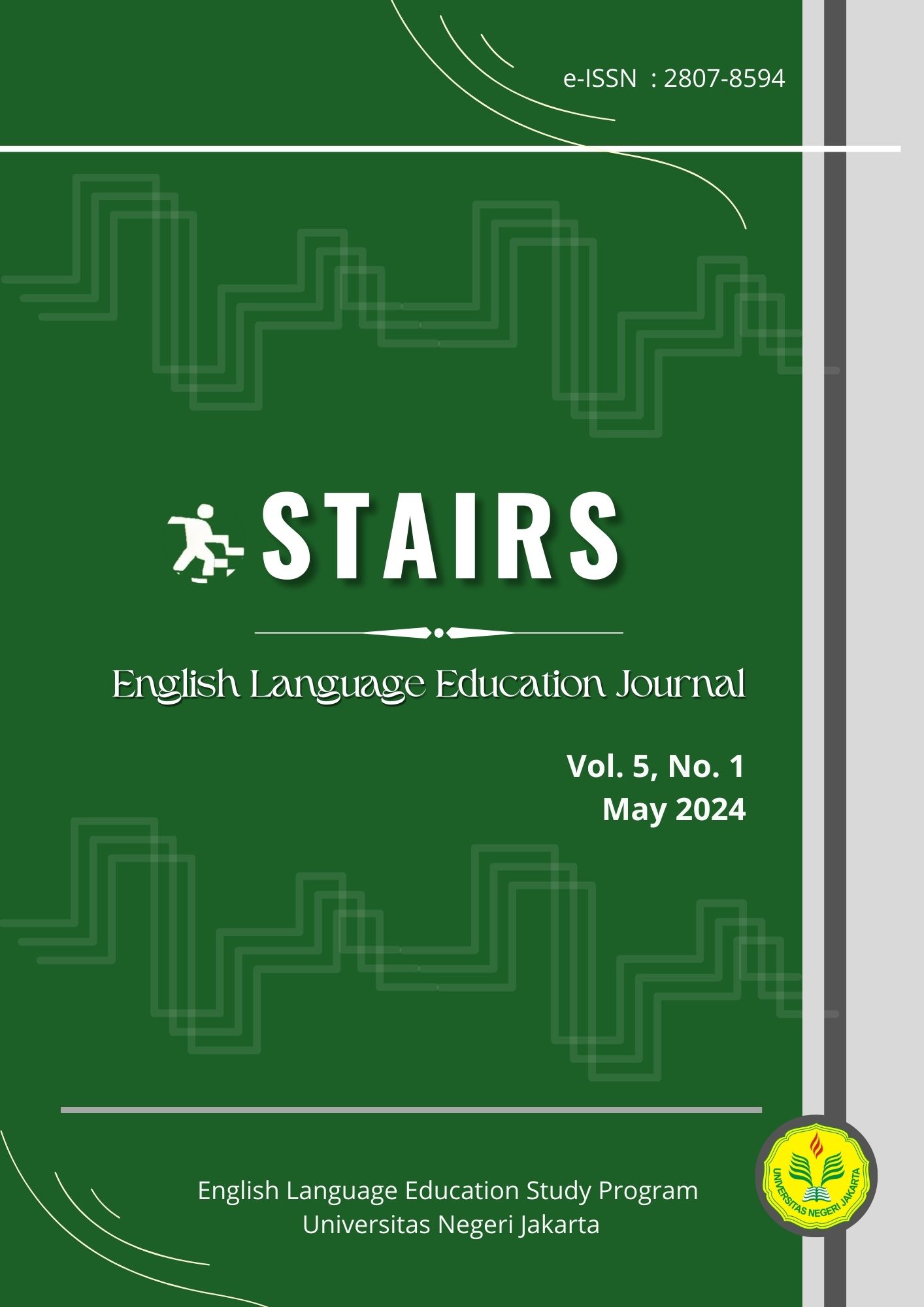Gender Representation in The English Textbook Entitled “Stop Bullying Now” for SMA/ MA/ SMK/ MAK Grade XI
DOI:
https://doi.org/10.21009/stairs.5.1.5Keywords:
Gender equity, Gender representation, Textbook analysisAbstract
Textbooks serve as a primary source of knowledge and play a critical role in shaping students' perceptions of social norms, including gender roles. This raises the need to examine whether textbooks have actively supported gender equity or still reinforce traditional gender stereotypes. This research aims to analyze gender representation in a textbook using a quantitative approach and the gender representation grid developed by Brugeilles and Cromer (2009). The findings reveal a significant dominance of male characters in the representation within the textbook, indicating an imbalance in gender representation within the textbook. Moreover, male characters tend to be assigned roles that align with gender stereotypes prevailing in patriarchal societies. These findings carry significant implications for creating inclusive and diverse learning materials to ensure they reflect gender equality and diversity within society. By understanding and recognizing this imbalance, it is hoped that content developers will be motivated to produce more representative and gender-sensitive materials.
References
Acar-Erdol, T., & Gözütok, F. D. (2018). Development of gender equality curriculum and its reflective assessment. Turkish Journal of Education, 7(3), 117-135, https://doi.org/10.19128/turje.376480
Ampera, D. (2012). Kajian kesetaraan gender dalam pendidikan di sekolah dasar mitra PPL PGSD. Jurnal Tabularasa PPS UNIMED, 9(2), 229–246, https://digilib.unimed.ac.id/id/eprint/689
Azisah, S. (2017). Gender Representation in English Textbooks of 2013 Curriculum in an Islamic Junior High School in South Sulawesi Indonesia. Proceeding: International Conference on Natural and Social Sciences.
Barr, E., Popkin, R., Roodzant, E., Jaworski, B., & Temkin, S. M. (2024). Gender as a social and structural variable: Research perspectives from the National Institutes of Health (NIH). Translational Behavioral Medicine, 14(1), 13–22. https://doi.org/10.1093/tbm/ibad014
Bennett, J., Hogarth, S., Lubben, F., Campbell, B., & Robinson, A. (2009). Talking Science: The research evidence on the use of small group discussions in science teaching. International Journal of Science Education, 32(1), 69–95. https://doi.org/10.1080/09500690802713507
Brugeilles, C., & Cromer, S. (2009). Analysing gender representations in school textbooks. CEPED.
Burgess, M. C. R., Stermer, S. P., & Burgess, S. R. (2007). Sex lies, and video games: The portrayal of male and female characters on video game covers. Sex Roles: A Journal of Research, 57(5-6), 419–433. https://doi.org/10.1007/s11199-007-9250-0
Curaming, E. M., & Curaming, R. A. (2020). Gender (in) equality in English textbooks in the Philippines: a critical discourse analysis. Sexuality & Culture, 24, 1167-1188.
Fahriany, F.. Alek., & Wekke, I. (2019). Gender Representation in English Textbooks for Islamic Junior High School Students. Kafa`ah Journal of Gender Studies, 8(2), 149. https://doi.org/10.15548/jk.v8i2.221
Gailea, N., & Mulyana, A. (2020). Gender Equality in Online English Book in Reading and Writing Materials. ELTR Journal, 4(1), 76-90.
Hornbæk, K., & Oulasvirta, A. (2017). What is interaction? Proceedings of the 2017 CHI Conference on Human Factors in Computing Systems (pp. 5040-5052).
Hsieh, H. F., & Shannon, S. E. (2005). Three approaches to qualitative content analysis. Qualitative health research, 15(9), 1277-1288.
Hutaluju, J. P. (2015). Analisis peran perempuan dalam pertanian Di kecamatan rasau jaya kabupaten kuburaya. Journal Social Economics of Agriculture, 4(1), 83-90, https://doi.org/10.26418/j.sea.v4i1.10135
Islam, K. M. M., & Asadullah, M. N. (2018). Gender stereotypes and education: A comparative content analysis of Malaysian, Indonesian, Pakistani and Bangladeshi school textbooks. PloS one, 13(1), e0190807.
Khotimah, K. (2009). Diskriminasi gender terhadap perempuan dalam sektor pekerjaan. YINYANG: Jurnal Studi Gender & Anak, 4(1), 158-180.
Lee, H., & Pollitzer, E. (2016). Gender in science and innovation as a component of inclusive socioeconomic growth. Portia Limited.
Lee, J. F., & Chin, A. C. (2019). Are females and males equitably represented? A study of early readers. Linguistics and Education, 49, 52-61, https://doi.org/10.1016/j.linged.2018.12.003
Leung, L. (2015). Validity, reliability, and generalizability in qualitative research. Journal of Family Medicine and Primary Care, 4(3), 324.
McCauley, A., & Ruggeri, A. (2018). Formulating Research Questions & Designing Research Projects in International Relations.
Merritt, R.D., & Kok, C.J. (1995). Attribution of gender to a gender-unspecified individual: An evaluation of the people = male hypothesis. Sex Roles, 33, 145-157, https://doi.org/10.1007/BF01544608
Puspitawati, H. (2013). Konsep, teori dan analisis gender. Bogor: Departemen Ilmu Keluarga dan Kon-sumen Fakultas Ekologi Manusia Institut Pertanian.
Rachmijati, C., & Cahyati, S. S. (2018). Gender Representation in Textbook Bahasa Inggris Grade X. ELTIN Journal, Journal of English Language Teaching in Indonesia, 6(2), 59-69.
Sachs, J. D., Lafortune, G., & Fuller, G. (2024). The SDGs and the UN Summit of the Future: Sustainable Development Report 2024. Dublin University Press. https://doi.org/10.25546/108572
Sadker, D., Earley, K. Z. P., McCormick, T., Strawn, C., & Preston, J. (2014). The treatment of gender equity in teacher education. Handbook for achieving gender equity through Education (pp. 161-180). Routledge.
Shastri, A. (2014). Gender inequality and women discrimination. IOSR Journal of Humanities and Social Science, 19(11), 27-30.
Stockwell, G. (2013). Technology and Motivation in English-Language Teaching and Learning. International Perspectives on Motivation, 156-175, https://doi.org/10.1057/9781137000873_9.
UNESCO. (2014). UNESCO Education Strategy 2014-2021, UNESCO. https://unesdoc.unesco.org/ark:/48223/pf0000231288
Werdiningsih, W. (2020). Analisis kesetaraan gender pada pembelajaran program keahlian teknik di SMK PGRI 2 Ponorogo. Kodifikasia: Jurnal Penelitian Islam, 14(1), 71-92, https://doi.org/10.21154/kodifikasia.v14i1.1915
World Economic Forum. (2023). Global gender gap report 2023. World Economic Forum. https://www3.weforum.org/docs/WEF_GGGR_2023.pdf
World Health Organization. (2023). Gender and health. Retrieved from https://www.who.int/health-topics/gender



